There is a wide variety of musical instruments in the world. There are those that are popular and famous in all countries of the world, for example, piano, guitar, harmonica. And there are ethnic ones that are not so common in everyday life and are not familiar to many people at all (for example, sitar, jew's harp or trembita).
It is interesting that all the tools that have gained worldwide popularity today were once characteristic only of some small community of people. It was only with the passage of time that they became widespread. Here comes the ukulele, Hawaiian folk instrument has gained popularity all over the world in the last few years. Let's deal with the specifics of this instrument and talk about what types of ukulele you can find.
Ukulele - what is it?
The history of this instrument began in the century before last, around the 1880s. On the island of Madeira (one of the autonomous regions of Portugal), at one time a small variety of guitar, the bragina, was popular. Ukulele, in fact, is a kind or logical continuation of the Portuguese instrument.
The ukulele has only 4 strings, although there are types of ukuleles that have eight strings (4 pairs of double strings are stretched on such instruments).
Types of ukulele and instrument range
It should be understood that such a miniature instrument with a small number of strings is simply not enough to cover a large range of notes. Nevertheless, its sound is able to please the ear.
What types of ukulele are there? The separation goes along the length of the tool. Different varieties of the instrument have different pitches, which allows you to collect mini-orchestras and play music that has a beautiful surround sound. The small guitar is widely used as a miniature rhythm instrument to accompany songs.
The main types of ukulele and their differences can be described as follows:
- Soprano - which is 53 centimeters long, is the most common due to its compactness. By the way, it was the first ukulele.
- Concert ukulele - differs in that its length is 5 centimeters longer. By the way, due to the size, the instrument sounds louder.
- Tenor - length is 66 centimeters.
- Baritone and bass - both options are almost the same length, but differ slightly in sound.
What shape can a ukulele be?
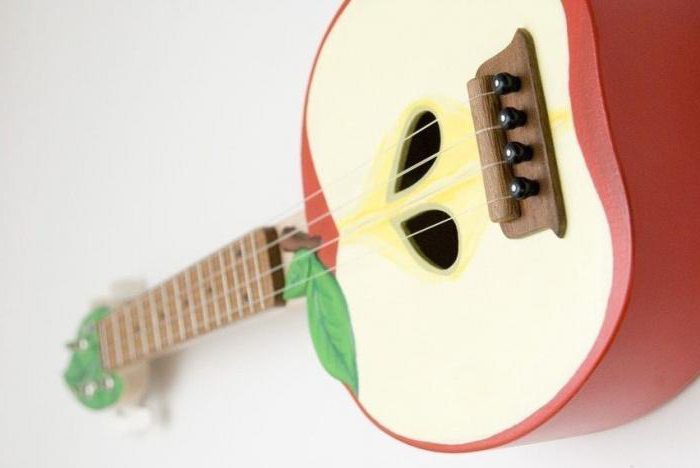
Types of ukulele may differ in design. The body of such a guitar can take absolutely any shape - it all depends on the inspiration of the master. There are classic mini-guitars, and round, and triangular and even square.
How to tune a miniature guitar?
Let's discuss how to tune the most common type of ukulele, the Soprano. It is worth noting that the main types of ukuleles are equipped with nylon strings.
In order for your instrument to sound right and for your guitar to fit standard chord fingerings, you should use a tuner or tune the instrument by ear with a tuning fork. The strings are numbered from the topmost, if you hold the guitar on your lap with the top deck facing you. standard tuning for the ukulele is BEFORE the first octave, it is also called C-tuning (GCEA).
- A4 (tuning fork La 440 hertz).
Guitar lovers will be surprised by the fact that the strings do not decrease in height, the fourth string is not tuned lower, as is the case with a conventional guitar, but, on the contrary, higher, in one octave with the rest.

Ukulele type "Baritone" - tuned similarly to the four strings of a conventional guitar:
Conclusion
The ukulele is a great outdoor accompaniment instrument. The playing technique is quite simple, and soft nylon strings it will not be difficult to play chords (by the way, many of them can be played with one or two fingers). You can always take such an instrument when going to visit friends, entertain yourself and the company at a large table. There are many ukulele songs on the Internet, and you can always find your favorite music and play it on a miniature guitar.
The folk ukulele is becoming more and more popular among Russians. It can be taken everywhere with you because of its small size, and it is quite easy to play on it. However, when buying, you need to know how to choose a ukulele and where to buy. How to choose a ukulele will be discussed in our article, and good prices I’m waiting for you on the ukulele in the store: https://noisemarket.ru/.
How to choose a ukulele: types of ukulele
If you decide to play the ukulele, choose suitable look tool:
- Soprano- this model is the smallest and therefore the most common;
- Concert soprano- the guitar is slightly larger than the previous one, has a thin sound;
- Tenor- Differs in even larger size and lower sound;
- Baritone- has a sound similar to the baritone range;
- Bass- the largest guitar model range and with the lowest sound.
For novice fans of the Hawaiian instrument, experts recommend regular and concert soprano guitars, as they are easier to play.
What is a good ukulele made of?
Hawaiian instruments are made either from laminate, or from array. Each material has its positive and negative qualities.
Laminate has great strength and resistance to vibrations. Of course, such a guitar will last for many years, but the laminate reduces the sound quality.
The array is less resistant to vibration, so the sound will be more pleasant and velvety. But the tool can deteriorate faster from humidity and temperature changes.
A good expensive ukulele is made from such types of wood as maple, walnut, spruce, pluswood.
How to choose a ukulele
If you enter the phrase “ukulele buy Moscow” into a search engine, then you most likely decided to master the Hawaiian art at the capital level. When choosing a ukulele, pay attention to the following points:
- Appearance: the guitar should be liked externally;
- sound: The openness and duration of the sound is the key to quality. The strings should sound even and at the same volume.
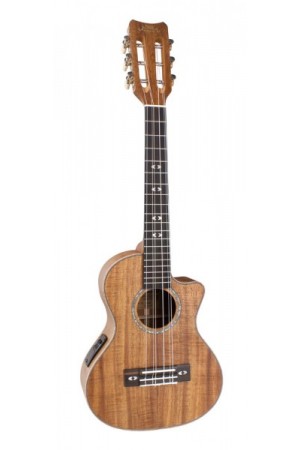 pay attention to Ukulele Lanikai. This is one of the most famous brands in the world of musical instruments. Ukulele brand Lanikai will surprise you with the tenderness of sound and sophisticated design. You can buy Lanikai ukuleles and other manufacturers.
pay attention to Ukulele Lanikai. This is one of the most famous brands in the world of musical instruments. Ukulele brand Lanikai will surprise you with the tenderness of sound and sophisticated design. You can buy Lanikai ukuleles and other manufacturers.
Another one famous ukulele brand — flight. The first guitars appeared in the 80s and immediately won the hearts of musicians. Flight brand ukuleles are well suited for learning as they possess excellent quality at an affordable price.
Ukulele price: features
The cost of guitars varies depending on the brand and model. But in any case, the money spent is worth it to surprise all your friends with a perky Hawaiian song.
Musical Instrument: Ukulele
Hawaii… The gentle rustle of the warm ocean, slender natives, sensually dancing a national dance to the accompaniment of an exotic instrument. The dream of many people is to visit this paradise on Earth and admire its beauties. The most famous landmark of the Hawaiian Islands is the smallest, but very proud guitar, which received the funny name ukulele. This word has two meanings: the first is a jumping flea, and the second, if the word is divided into two parts, is an incoming gratitude. Due to its small size, the instrument, which is more reminiscent of a child's toy, has gained popularity among many music lovers in all corners of the globe in a short time. The ukulele, which is not difficult to learn and compact in size, makes it possible for music lovers of different ages to play the instrument. Melodic, with a special inimitable sound, the instrument reflects the colorfulness of the Pacific coast with its mysterious romance.
The ukulele is the national symbol of the Hawaiian Islands.
Sound
The interesting sound of the instrument is distinguished by lightness and cheerfulness. The timbre is as sunny as the smiles of hospitable Hawaiians.
The ukulele, like all guitars, is plucked string instrument and the sound on it is the result of the vibration of the strings.
The range is small, only two octaves. System: 4th string - "salt"; 3 - "before"; 2 - "mi"; 1 - "la".
The main methods of producing sound on the ukulele are plucking and striking the strings, which are extracted with the fingertips. right hand, and sometimes with a special felt plectrum (plectrum).
In addition to the basic ones, performers use all kinds of guitar sound production techniques on the instrument: barre, arpeggio, arpeggio, legato, tremolo, ascending and descending legato, bend, vibrato, glissando, staccato, tambourine, golpe, harmonics.
Photo:


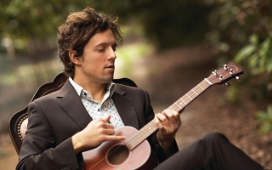
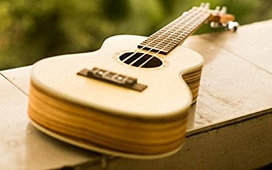
Interesting Facts
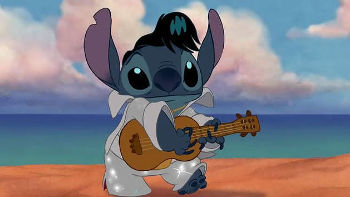
- There are three versions of why the tool has such a name. First, when Hawaiians first saw and heard the ukulele, they were intrigued. It seemed to them that the performer's fingers jumped over the strings like fleas, hence the name, which in Hawaiian means a jumping flea. According to the second version: an Englishman named Edward Purvis, who knew how to play the ukulele, served as chamberlain for the King of Hawaii, David Kalakaua. The chamberlain was short, and when he played the instrument, he grimaced a lot, because of this, he, and with it the Englishman's favorite instrument, was called the jumping flea. And the third and last one: the Queen of the Hawaiian Islands, Liliuokalani, called the word ukulele a gift from afar, literally “gratitude that came” (uku - gratitude and lele - to come).
- The first copy of the ukulele was sold for only 75 cents.
- The popularity of the instrument can be judged by how often we see it on our TV screens. The stern Dr. Gregory House, the hero of everyone's favorite series of the same name, as well as the funny Stephanie Gooch in the series "Clinic" play music on the ukulele.
- The ukulele also appears in animated films, such as Walt Disney's popular cartoon Lilo & Stitch, which was set in Hawaii.
- In the world-famous comedy film Only Girls in Jazz, the inimitable Marilyn Monroe, who played the role of Darling Kane, played the ukulele in the orchestra.
- "King of rock and roll" Elvis Presley was also a fan of this musical instrument.
- In Russian literature, we find the mention of the instrument in I. Ilf and E. Petrov.
- The Japanese first met the ukulele in 1929, brought to the country by Hawaiian origin Yukihiko Haida. He even organized the "Association of Ukulele Players", as the instrument gained great popularity in Japan.
- The current fascination with the instrument is so great that Louis M. Glackens produced a cartoon in 1916 that satirizes the current ukulele craze.
- In the 1950s, when the plastic boom began in the US, plastic ukuleles were one of the most popular gifts. These instruments had a lower cost and a slightly different sound.
- There is a ukulele orchestra in the UK, which is very popular and performs with great success all over the world. The orchestra's repertoire includes musical compositions by David Bowie, the American rock band Nirvana, and even works by P. I. Tchaikovsky.
- The first man to walk on the moon, Neil Armstrong loved to play the ukulele. After his flight into space, he spent several weeks in quarantine, strumming on his instrument.
- George Harrison, the legendary lead guitarist of the Beatles, was a fan of the ukulele. While vacationing in Hawaii, where the musician had his home, he in large numbers bought instruments and then gave them away to all his friends.
- Today, there are many ukulele manufacturing firms both in Hawaii and in other parts of the world. Some tool makers have made huge profits in recent years
- The Chinese company Xiaomi has released a smart electronic ukulele called Populele. For training, you only need to connect the instrument to mobile application and 72 LEDs built into the body of the instrument will tell you how to place your fingers on the neck.
- The length of the world's largest ukulele is 3 meters 99 centimeters.
- Now the price of a tool made from the Hawaiian koa acacia is very high and can be up to two thousand US dollars.
Design
The design of the ukulele is the same as that of the guitar and consists of a hollow body with a resonator hole and a neck.
- The body is usually in the shape of a figure-eight, but there are other options: round, square, which were made from wooden cigar boxes, in the shape of a pineapple or an oar. The body has two decks: upper and lower, interconnected by shells. A string holder is attached to the top deck.
- The neck is usually carved from a single piece of wood that is harder than the body of the instrument. On the one hand, the neck is attached to the ukulele by the heel, and on the other hand, it has a head, on which there are pegs for string tension. A fingerboard is glued to the neck, separated by metal nut. The nut divides the fretboard into frets. Between the neck of the neck and the headstock is the nut.
For the manufacture of ukuleles, the following tree species are used: ash, agatis, acacia, mahogany, maple, rosewood, spruce, walnut. However, cheaper tools are made from laminate and plastic.
There are four strings on the instrument and usually nylon strings are used.
The total length of the ukulele is 53 cm.
Varieties
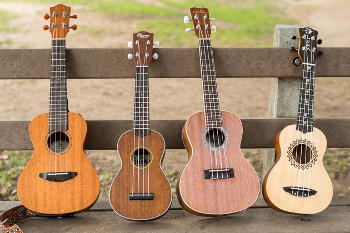
The ukulele family is quite diverse and includes seven types of instruments. The most common types are soprano, concert, tenor and baritone. Ukuleles piccolo (bambino), bass and contrabass are used less.
- Soprano is the most popular instrument, its sound is considered classical. Length is 53 cm, system: salt, do, mi, la, number of frets: 12-14.
- Concert - a little more than soprano and sounds a little louder. Length 58 cm, system: salt, do, mi, la, number of frets: 12-14.
- Tenor - has a rich, deep, velvety sound. Length 66 cm, system: salt, do, mi, la, number of frets: 15-20.
- Baritone - has a rich sound. Length 76 cm, system: re, salt, si, mi, number of frets: 15-20.
Sometimes there is another type of ukulele, which differs from the rest in paired strings. Each of the strings has a duplicate tuned in unison.
Notable artists

Hawaiian music with its unique national flavor has always attracted and inspired people in different parts of our planet. The ukulele, a small instrument with great potential, has also attracted the attention of music lovers, and has now moved from the camp of exotic instruments to the camp of revered and popular ones. Performers of various styles are increasingly decorating their musical compositions with the sound of the ukulele. The instrument has taken root perfectly in such genres as traditional Hawaiian music, jazz, country, reggae, folk, gospel, pop, country, ragtime, swing and even techno.
Many talented musicians, being carried away by playing it, without suspecting it, contributed to the popularization of the ukulele.
One of the most famous ukulele players was a Hawaiian with a hard-to-pronounce name, Israel Kamakawiwo'ole, who was affectionately called a gentle giant, as well as a true god of the ukulele.
The inhabitants of the islands rightly called Gabby Pahinui, who, together with Eddie Kamae, created the group "The Sons of Hawaii" a true patriot. The compositions of this group reflect the beauty of the national music of Hawaii.
The magicians and wizards of the instrument were:
- Roy Smeck is an American musician who received the nickname "The Magician of the Strings", a virtuoso on the ukulele, in his hands the instrument turned into an extraordinary miracle.
- Lyle Ritz - American jazz ukulele player; Cliff Edwards is a popular American singer, actor and ukulele master.
- George Formby is an English actor, comedian, singer who perfectly accompanies himself on the ukulele.
- Also not to be missed are such famous ukulele players as Jim Beloff, Herb Ohta, Troy Fernandez, Kimo Hussey and Chalmers Dawn.
- Nowadays, the ukulele sounds skillfully in the hands of Jake Shimabukuro, a performer and composer, a young virtuoso guitarist from Honolulu, who became famous for his amazing technique and received the nickname "Jimmy Hendrix who plays the ukulele."
- Rocky Leon is an itinerant musician, a kind of cosmopolitan. Travels the world and sings his songs to the accompaniment of the ukulele.
- James Hill is a Canadian musician who plays techno on the ukulele with sushi sticks and a comb.
Among the famous stars of rock, as well as popular music, who decorated their concerts with the sound of the ukulele, it should be noted Brian May, George Benson, Paul McCartney, George Harrison, Eddie Vedder, Jimi Hendrix, Dick Dale, Syd Barrett, Joe Brown, Amanda Palmer, Andrey Makarevich.
Story
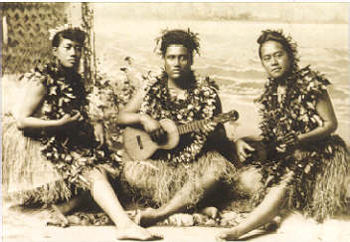
The history of the instrument begins in Europe, because miniature varieties of the guitar first appeared there, which can be confidently called the predecessors of the ukulele. The Portuguese kavakinho and braguinha, having got to the Hawaiian Islands, were modified into an instrument, which later became known as the ukulele, which means a jumping flea in Hawaiian. There is a legend that four brave Portuguese from Madeira - M. Nunez, A. Diaz, J.E. Santo and J. Fernandez, in search of a better life, decided to try their luck on one of the Pacific islands, on sugar plantations. In the end, three of them: M. Nunez, A. Diaz, J. E. Santo - cabinetmakers by profession, decided to settle in the small town of Honolulu to open their own furniture production there. However, the dreams of the Portuguese did not come true: the Hawaiians did not like the Portuguese furniture.
Then the friends decided, in order to survive and somehow earn their living, to try to make musical instruments - small guitars that they brought from their homeland: cavaquinho and bragino. Their experimental endeavors resulted in a new instrument.
It is not known for certain when this happened, and which of the friends made the first ukulele, but the name M. Nunez is on the instruments that have survived from that time, and the estimated time is 1886. However, it is known for certain that the first virtuoso musician who became famous for playing the ukulele was J. Fernandez.
At first, the locals did not like the instrument of foreigners at all, and they did not call it otherwise than “disgusting”. But the Portuguese did not give up - they even arranged nightly street concerts, which were announced by local newspapers. But the king David Kalakaua, who was ruling in Hawaii at that time, nicknamed by his contemporaries as the “jolly monarch”, liked the ukulele. Hiring one of the Portuguese immigrants to learn how to play the instrument, he subsequently advocated that Hawaiian folk songs and the national hula dance be performed to the accompaniment of the ukulele. Kalākaua fell in love with the instrument so much that he introduced it to the royal orchestra, and the sound of the ukulele began to accompany the royal receptions. The locals were inspired by the respect that for the manufacture of the ukulele they used a tree that on the islands displays reverence for nature, the Hawaiian acacia - koa. Before the immigrants arrived with their instruments, the folk art of the local population was dominated by monotonous songs (oli), and national dances were accompanied only by drum rhythms. With the advent of the ukulele, Hawaiian culture was actively changing, as the indigenous people, who quickly mastered the instrument, associated it with their folk art. The popularity of the ukulele grew every year, and within 10 years it became a symbol of Hawaii, embodying the national cultural identity.
World fame for the ukulele came a little later. In 1998, after the United States annexed the possessions of the Hawaiian kingdom, the small guitar began to appear more and more in the Americas. And in 1915, after the debut performance of the Royal Quartet from the islands in San Francisco at the international Pacific-Panama exhibition, "uke" begins its triumphal procession and wins the hearts of people not only in the States, but all over the world. The popularization of the instrument was facilitated by the increased interest in Hawaiian culture, the ease of mastering the ukulele and its relatively low cost. The instrument, which has become a fashion brand, is often used in the performances of famous artists. It is recommended as a cure for depression. Three American firms have put the production of ukuleles on stream. Work is underway to improve the instrument, as a result, new varieties appear: soprano, concert, tenor and baritone.
The coming "black" October 1929 made its own adjustments to the life of the Americans, who were not up to fun and forgot about the ukulele for a while. Only after the end of the Second World War, the instrument returned to the life of Americans again thanks to the soldiers stationed in Hawaii, who carried the ukulele as an exotic souvenir. Interest in the instrument flared up with renewed vigor, famous artists contributed to its popularization. The ukulele again began to appear on pop stages and cinema screens.
Today man lives in the world high technology and high speeds. But sometimes you really want to escape from problems and plunge into the world of wonderful dreams. An elegant instrument from the Pacific Islands can be a good helper in this. Easy to learn, because in just 30 minutes you can learn 3 or 4 chords, which are enough to accompany a simple song, a compact instrument will always brighten up your leisure time, cheer you up, and most importantly - give you pleasure from playing. Another important argument about the benefits of the ukulele is that it can help your children start their musical education and develop fine motor skills. Acquaintance of a child with such an instrument is possible from a very early age.
Video: listen to the ukulele
Ukulele tuning
The ukulele is a fun and very enjoyable instrument. Traditionally, the ukulele uses a set of four nylon strings. It must be remembered that even the best nylon strings are very stretchy at first after installation and do not hold the system. It's okay - the strings gradually stretch, the tension stabilizes and the tuning of the instrument becomes stable.
- Standard ukulele tuning A E C G
- High action A D F# B
- Canadian A. D F# B
- Russian tuning A C E G
How to tune the ukulele:
1. Tune the 3rd string to C
2. Press the 3rd string on the 4th fret and tune the 2nd string E to this sound
3. Press the 2nd string on the 3rd fret and tune the 4th G string to this sound
4. Press the 4th string on the 2nd fret and tune the 1st string A to this sound
Varieties of ukulele
There are 4 main varieties of ukulele: soprano, concert, tenor, baritone (soprano, concert, tenor, baritone). The most common and popular varieties are soprano and concerto.
Ukulele Soprano. The body length is within 51-53 cm. The average length is 330mm/13"". The ultra-compact body, lightness and unpretentiousness made this variety the most popular.
Ukulele Concert. The size of the case is within 56-58 cm. The average length is 380mm/15"". Due to the increased body size and wider scale, the ukulele is more comfortable to play in concert, and the musical quality is higher than that of the soprano ukulele.
Ukulele Tenor. The body is within 66-68 cm. The average length is 430mm/17"". This variety of ukulele has a deep and velvety sound. As a rule, it is the tenor ukulele that is played by professional performers.
Ukulele Baritone. Case size 76-78 cm. Average length 480mm/19"". The sound of this variety is perhaps the closest in musical quality to ordinary guitars and the richest of all ukuleles. However, the large size of the instrument and the differences in tuning methods noticeably affect its popularity.
_______________
Features of the care of the ukulele
The ukulele is a fragile instrument that requires attention. If your ukulele has begun to lose its presentable appearance, we recommend using special tools in the form of polishes and cleaning products for the care of musical instruments. In case of severe pollution, you can use folk remedies - Russian vodka or household gasoline "galosh". When not in use for a long time, we recommend lowering the string tension. To store the ukulele, we recommend using a case or case.
History of the ukulele
brief historical background

The history of the guitar with the unusual name "ukulele" begins in the 19th century. According to one old legend, this musical instrument came up with four desperate Portuguese from the island of Madeira - Manuel Nunez, Augusto Diaz, Jose do Esperito Santo and Joao Fernandez. Once these daredevils crossed the ocean and landed in the port of the small town of Honolulu, on the island of Oahu in the middle of the Pacific Ocean. It happened back in 1879. At first, the Portuguese did not find anything better than to engage in carpentry and began to actively make expensive Portuguese furniture. Of course, this business did not work out and friends were on the verge of financial collapse. It was at this moment that one of the friends decided to sing a song about their everyday troubles and took out of the suitcase two small Portuguese guitars brought with them from Madeira - rajao (port. machete de rajão) and braguinha (port. braguinha) - the Madeiran variety of the beloved Portuguese cavaquinho (port. cavaquinho). It was then that the guys came up with the idea to combine these two tools into one and make good money on it. This day turned their lives upside down and gave the world a ukulele! In fairness, it should be noted that these varieties of small Portuguese guitars were noted not only in sunny Hawaii, but also spread during the 18th-19th centuries to many countries and islands of the Pacific region, the Caribbean and South America, adopting local distinctive features and names (charango, cuatro, bandola, cinco, bocona, jarana, etc.)
A few years passed and the compact Portuguese guitar began to spread widely in Hawaii. The Hawaiian king David Kalakaua himself began to play the new instrument, which received the amusing name "ukulele" from the local natives. People began to perceive this instrument as part of their own music. However, this guitar gained wide world fame thanks to the American music industry. In 1898, the United States annexed the Hawaiian Islands. After that, the ukulele began to appear in American music circles, in concert programs and, later, on movie screens. The excitement around the ukulele grew, in part, thanks to the tour of the Royal Hawaiian Quartet at the Pacific-Panama Exhibition of 1915 in San Francisco. After leaving for wide audience, American manufacturers expanded the ukulele family and during the 1920s and 30s, four varieties of this guitar were established in practice: soprano, concerto, tenor and baritone. The ukulele has become a global brand and is recommended to people as an effective medicinal product against sadness. It is known that George Harrison himself loaded the trunk of his car with bundles of ukuleles, after which he traveled around the cities and presented this positive musical instrument to everyone he met. Rumor has it that the translation of the Hawaiian word "ukulele" sounds like this: "a gift that came by itself." They also say that the first copy of this instrument was sold for only 75 cents. This is such a fun ukuleleshnaya story))
Modern guitars stun the whole world with their variety. Despite the huge number of current types, all guitars have a lot of similarities, but no less differences. An example is the modern bass guitar and electric guitar. Both types are absolutely identical in terms of external indicators of the case, however, they perform absolutely different functions. One of the little-known types is the ukulele ukulele.
Despite the familiar name, this type of small guitar has its roots in Portugal, where it first appeared in 1880. Since then, the use of the guitar in Europe has been found only in a few cases, but its use is widespread in various Pacific islands, in particular, in Hawaii, where almost every musician related to the stringed instrument is intimately familiar with the ukulele.
Back in 1915 Hawaiian musicians held a whole exhibition, accompanied by compositions on the ukulele. Since then this type guitars are considered to be Hawaiian, hence the name. Despite the warm reception of the instrument in those years, in our time the ukulele has not received the title of a professional musical instrument.
To date, not a single professional musician performs with this guitar on the big stage, but it is worth noting that many European experts own it. The fact is that with the help of the ukulele, you can give all known compositions a special sound that has no resemblance to the sounds classical guitar despite some instrumental similarities.
Specifications of the ukulele
Like the classic version, the small guitar uses nylon strings that are specially made for the ukulele. The fact is that the structure of such a guitar is fundamentally different from the usual classics or acoustics, and it can be difficult to tune the strings for a classical naukulele guitar. The small guitar has only four strings, which are built into the notes G, C, E, A (Sol-Do-Mi-La), respectively. This leads to the conclusion that the first string of the ukulele is built in the note G (sol), which is two tones higher than the first string of a classical guitar. The density of even the highest quality classical strings does not allow such tension to be achieved without damaging the strings themselves or the guitar. 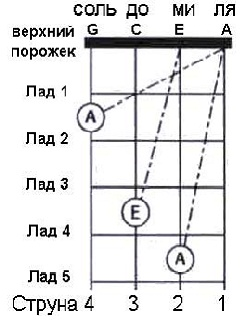
The ukulele is also called the "little guitar" because of the size of the instrument. To date, the length of the largest device of this type does not exceed 76 cm. This is a ukulele, which has its own name - baritone. The soprano ukulele, 53 cm long, was the first to appear on the market. Hawaiian experts performing at that time with this instrument created the so-called concert version, which exceeded the previous one in length by 5 cm. There is also a tenor ukulele, which is built in a different key due to the length of 66 cm. 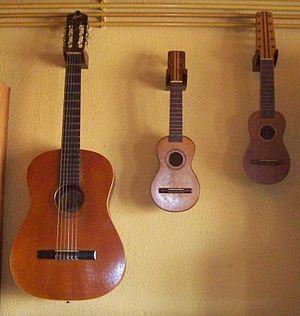
There are only 12 frets on the fretboard of such a guitar, regardless of the subspecies. It is worth noting that despite the popularity of solo parts for the ukulele, playing with a plectrum on this tool not accepted. In principle, the distance between the strings allows you to safely use your fingers in the work area. 
According to historical data, the tree from which the first small guitar was created in Portugal is unknown, but modern ukuleles are made exclusively from the Hawaiian koa tree, which has a second name "mahogany". Many manufacturers also use this material when creating acoustic and electric guitars. Such devices, it is worth noting, exceed competitors in cost. 
One of the main advantages of the ukulele is the price. To date, the cost of the highest quality small guitar corresponds to the price of a classic fixture from an average manufacturer. Such an instrument can be an excellent addition to the usual types of guitars as a method of self-development and finger practice.
Due to the number of strings and the special tuning, we can conclude that it will not work to play the usual chords on this instrument. However, learning to play the ukulele does not take long, especially if you already have some skills in playing other types of guitar. When compared with a seven-string fixture, it takes two or even three times less time to learn ukulele chords, depending on the level of your playing.
